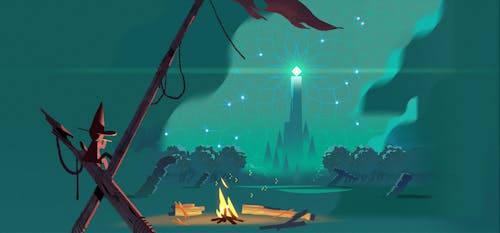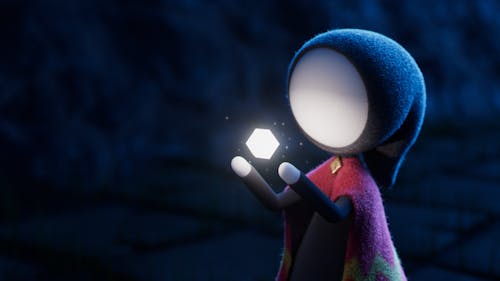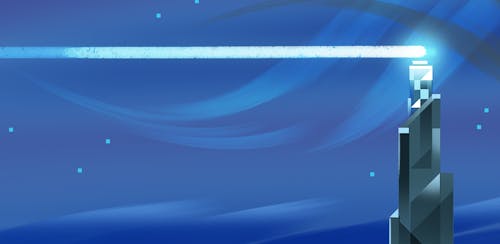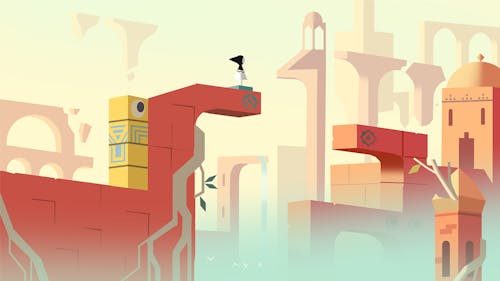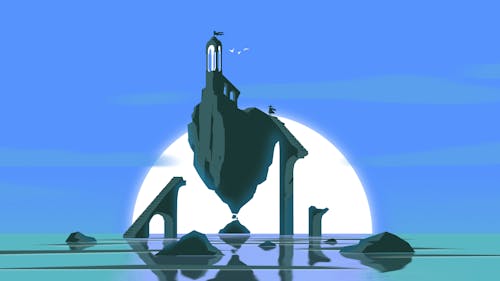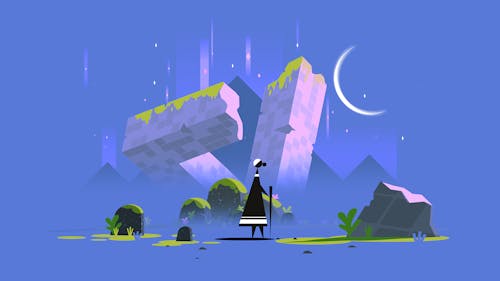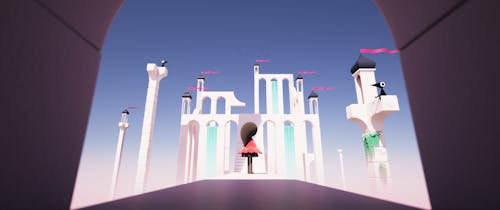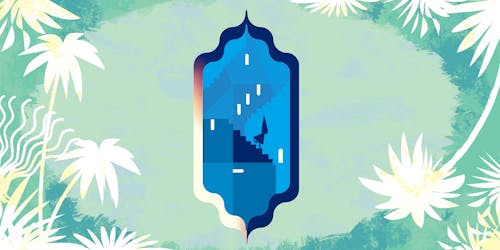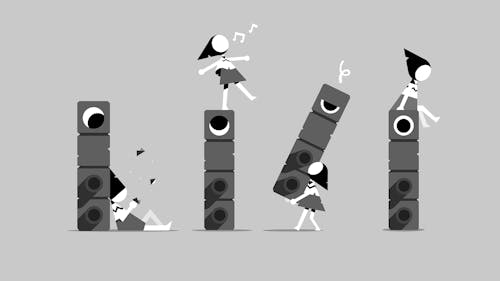Monument Valley 3: The Lighthouse
Sula washes up on a mysterious island full of puzzles, illusions and surreal challenges. Will she unlock the island's secrets and reconnect with her lost community?
Monument Valley is a groundbreaking, award-winning indie game series renowned for its meditative puzzle-based mechanics and beautiful art direction.
We were entrusted by ustwo Games & Netflix Games to create a cinematic story set within the Monument Valley universe to promote the launch of the latest game in the series, Monument Valley 3.
Story
The film is set in a world adjacent to the game, which freed us up to construct a narrative with drama and cinematic cameras in mind, bringing something new to the Monument Valley universe. We worked closely with the game development team to highlight key themes that felt important to carry over to the animation, even if peripheral; traces of a climate disaster, the natural world and the importance of community.
Working alongside scriptwriter Leo Amiel and the team at ustwo games, the project began as a series of short episodic vignettes with far-ranging ideas and different characters. Over time, we all moved towards a longer and singular story that gave us more of a framework to explore the puzzles and environment and more closely mirrored the pacing of the games.
As the stories in the games are more “felt” rather than “told” without dialogue or any narration, we knew we needed a story with emotional resonance. A character washing ashore on an island, in which we, as viewers, discover the island through the eyes of our protagonist, felt like an apt way to introduce a new perspective on Monument Valley.
We hoped that by keeping the story light and giving enough time to explore the island's wonders, we would honour the atmosphere of the games. Simple story beats such as discovering a companion's hat, felt almost like a storybook and helped keep the story feeling universal.
Puzzles
One of the main challenges in approaching a Monument Valley film is breaking the isometric camera to allow a more intimate and emotional story to unfold. By changing the camera, we broke the gird and had to introduce new types of puzzles and playful visual reveals. We looked at symmetry in composition and experimented with traditional cinematic techniques such as dolly zooms, match cuts & symmetry to introduce new types of puzzles.
Early in development, our AD and CG lead, Luke Doyle, created a concept frame that unlocked the film's art direction. It was a long-lensed camera with a forced flat perspective of the ground. Something that is almost impossible angle for traditional 3D, without trickery, and felt more akin to a 2D illustrative style. We then began to wonder, what happens if we move from a very wide-angled, cinematic camera to this more flat perspective? This initiated the test of the shoreline and the film began to move in an interesting direction.
Each puzzle had it’s own visual or narrative snag, some of which were solved through storyboards or design frames, and some were solved by blocking it out in 3D via the expertise of one of our animators on the project, Milo Targett. Some puzzle resolutions even evaded us towards the end of production, such as the monumental aligning star seen from above.
We knew it would be fun to return, sparingly, to the isometric perspective of the game and the Scene in which Sula ascends the tower with Totem and the growing plant became this. As soon as we saw the scene in blocking, we knew it had the right energy and pacing to lend itself to some charming character animation and frenzied puzzle-solving. The icing on the cake was when we heard Todd Baker’s & Lucie Treacher’s rhythmic score build over this sequence. It gave us collective chills, and we felt we’d captured something special.
Design
The design language of Monument Valley was a gift to work with. It was a real dream project for us. Elegant & minimal compositions with dreamy-powdery colour palettes felt harmonious with what our studio naturally gravitates towards.
However, with that came the pressure to make a film that lived up to a game revered for its ingenuity and design aesthetics
From the start of development, we knew we wanted to introduce textures in the film rather than the flat shaders used in the game. As with most good design, form follows function and having to move the camera closer to the characters to tell a more emotional story, gave us the function to bring in photo-real textures to help ground our characters. Bringing realistic textures into Monument Valley meant we could introduce reflective or transparent surfaces to unlock new visual puzzles.
While in early development, we reached out to concept artists such as Eusong Lee to help bring early ideas to life. Eusong’s visual development work had a big impact on the project. His sketches contained so many charming, “smile-in-the-mind” moments that we often built parts of the story around them.
Concepts became storyboards and were handed to Quentin Baillieux, who combined them with Joe Dennis’ sublime colour boards to create a real visual tonic. Quentin injected detail and dimensionality into his concept frames, allowing the 3D team to realise these scenes for the first time.
Character
A storm separates our main protagonist, Sula, from her friend Lori and her travelling boat community. We intended the design and texture of the characters to feel imperfect, to take on a slight miniature feel. Sula is animated on 2’s to enhance this feeling; we added slight tears and stains to clothing to add tactility and support the narrative. We wanted these small details to contrast the bold graphic patterns on Sula's shawl and sail, which aligned with the game's design principles.
Lori is set apart from Sula by his distinctive woven hat, hinting towards Eastern design aesthetics within the new game.
With the characters' lack of distinctive faces, conveying emotion was challenging. We navigated this by leaning into the art direction of each shot, using the warmth or coolness of lighting on the character to portray a feeling or emotion.
Totem was an interesting character to wrap our heads around. Whilst developing the story, it felt natural to imbue it with lots of personality and playfulness. However, after discussions with the team, it seemed more appropriate for Totem to act more as a vehicle that Sula would utilise. So even though Totem's eye expression is limited, we restricted expressions we could make with it and again leaned into the colour palette or the film's score to emphasise a mood or feeling.






